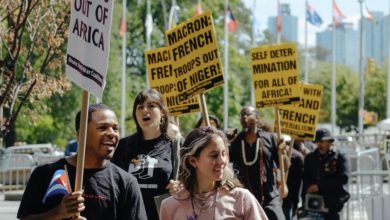Somalia, a geopolitically strategic location in the Horn of Africa on the Red Sea, the Gulf of Aden and the Indian Ocean, has been the target of imperialist domination since the 1880s.
 |
The proximity of Somalia to the oil-rich Middle East has intensified the competition. Over the past several decades the efforts of U.S. imperialism have splintered the country into territories controlled by warlords and embroiled in an internal armed conflict.
The conflict in Somalia gained media attention when the Southern port city of Kismayo fell to forces loyal to the Islamic Courts Union on Aug. 22. Thousands of people fled the city and 70 were reported dead, according to the Aug. 25 edition of the newspaper The Australian.
Western sources often paint the ICU as an illegitimate force wreaking havoc and creating a humanitarian crisis in Somalia, but a brief look at recent history shows the opposite is true.
Since 1991, Somalia has been without an effective centralized government. In 2004, the Transitional Federal Government that had been formed in exile brought together a collection of warlords who held control of the southern and southwestern portions of the country. The former imperialist colonizers recognized the TFG, even thought the TFG had little support inside Somalia. Simultaneously, the ICU emerged as an independent rival to the imperialist-backed TFG. The ICU, while having extremely conservative Islamic ideology, was able to gain the support of the masses of people in the southern and southwestern parts of Somalia.
In 2006, Ethiopia, acting as a proxy force for U.S. imperialism, invaded and occupied Somalia. Backed and supported by major western nations and their African allies, Ethiopia’s goal was to secure the areas nominally under control of the TFG and restore some semblance of a central government and stability to this strategically important country.
The invasion by Ethiopia was a direct response to the growth of the ICU in areas the TFG claimed to control. The ICU created the first somewhat unified national government in Somalia since 1991. However, the ICU did not control all areas of the country; Somaliland and Puntland, for instance, formed independent states in the north and central parts of Somalia. The ICU became the center for resistance to Ethiopia, their TFG allies and the U.S. puppet master.
Washington gets Ethiopia to do its dirty work
The conflict broke out in early 2006 in Mogadishu. The ICU was able to expand the areas under its control over the course of the year and push the TFG forces further and further south. The ICU was able to consolidate most of the territorial gains by making agreements with local tribal rulers. The ICU was able to gain enough control over the southern and southwestern portions of the country such that a centralized and viable Somali state began to emerge. By December 2006, the TFG warlord forces were more or less defeated.
But on Dec. 21, 2006, the balance of power shifted. Ethiopia invaded Somalia, displaced the ICU and drove it underground, forcing the ICU to function as a guerilla movement again. By early 2007, Ethiopia helped prop up the pro-Western TFG government by occupying the areas of the country that had been controlled by the ICU. On Jan. 9, 2007, in one final blow to the ICU government, Washington launched air strikes against one of the last cities held by the ICU to assist the Ethiopian forces.
Since December 2007, the Ethiopian military, with air and sea support from the Pentagon, has continued to occupy the southern part of Somalia, propping up the TFG government. The United States justifies it support of the Ethiopian occupation as part of the “war on terror.” Washington claims the ICU has some links to Al Qaeda, and would use Somalia as a base to attack U.S. interests in Africa and the Mideast. This reasoning is self-serving. It is possible that the ICU has some ties with Al Qaeda; it more likely has ties with other militant anti-imperialist resistance forces of an Islamic character.
A U.N. global arms trade document alleged that Egyptian and Saudi forces also provided assistance to the ICU. Terrorism cannot be the main reason behind U.S. support for the Ethiopian occupation and puppet TFG government. The demonization is meant to obscure the history of U.S. imperialism in Somalia and its effort to strengthen its domination of the region.
The Ethiopian forces occupying Somalia are acting as a proxy for implementing the National Security Strategy doctrine of the United States. In the aftermath of the overthrow of the Soviet Union, that doctrine stated that the foreign policy aim of the United Sates is to prevent the emergence of any regional or international power that can rival the United States for global domination.
The “war on terror” is a manifestation of this doctrine. It has been used to justify the invasion and occupation of Iraq with the aim to strengthen U.S. domination of the Middle East. It has been extended to Somalia to strengthen U.S. domination of the Horn of Africa. In Somalia, the U.S. saw the ICU as a force opposed to the U.S. agenda that could become a regional power to rival the United States. Therefore, in the interest of U.S. imperialism, the ICU could not remain in power.
The Horn of Africa, which includes Ethiopia, Eritrea, Somalia, and Djibouti, has been of strategic importance to the United States for some time. Former Secretary of Defense James Schlesinger hit the nail on the head when he stated, “The Horn of Africa is of particular strategic importance due to its geographical proximity to the troubled Middle East.” Somalia sits right near the Suez Canal and some of the most vital international shipping lanes. In addition, by ousting a government hostile to it in Somalia, Washington limits adversaries such as China from strengthening their presence in the region.
Struggle continues
The ICU is not a homogenous force. Its continued resistance to imperialism and its proxies is aided by the fact that other forces are fighting alongside its own against the occupation. The capture of Kismayo shows that, despite the U.S-sponsored Ethiopian occupation, the Somali people are determined to fight against the U.S.-backed warlords who have wreaked havoc on the country since 1991.
The ICU and the Somali resistance, in spite of their conservative ideology, are being targeted for no other reason than their desire to free Somalia from foreign occupation and domination. Progressives should stand in solidarity with those who are resisting imperialist intervention. Support for the right of self-determination is an essential component of an anti-imperialist perspective.





